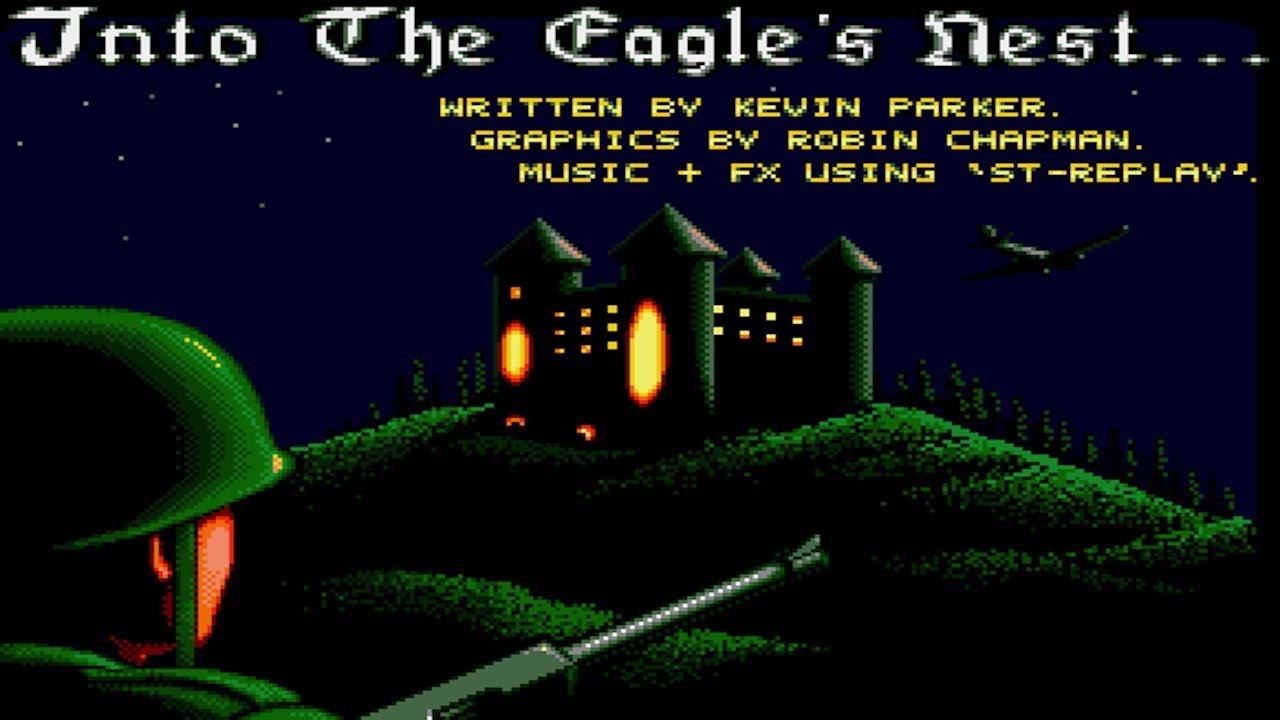Released during a transformative period in the video game industry, “Into the Eagle’s Nest” stands out as a quintessential example of early game design that melds action, strategy, and narrative in a compelling World War II setting. Developed by Pandora Software and published by Mindscape in the late 1980s, this game has left an indelible mark on the gaming landscape. Here, we delve deeper into the elements that made “Into the Eagle’s Nest” a noteworthy game of its era.
Intricate Game Design and Mechanics
“Into the Eagle’s Nest” was designed with a clear focus on combining various gameplay elements to create a challenging yet engaging experience. The game’s mechanics are a hybrid of real-time action and tactical planning, requiring players to be both quick on the trigger and smart in their overall strategy.
Resource Management
One of the key aspects of the game is resource management. Players must judiciously use their limited supplies of ammunition and explosives. Every bullet and stick of dynamite counts, pushing players to plan their moves carefully and conserve resources, adding a layer of tension and strategic depth not commonly found in games of that period.

Navigational Challenges
The game’s map plays a crucial role in navigation. Unlike many contemporary games that provided players with auto-mapping features, “Into the Eagle’s Nest” required players to memorize paths or draw their maps to keep track of their progress through the complex maze of the fortress. This requirement added an element of exploration and discovery, rewarding players for their attention to detail and spatial awareness.
Historical Context and Setting
Set against the backdrop of World War II, “Into the Eagle’s Nest” takes players on a suspense-filled mission inside a fortified Nazi stronghold. The historical setting is not just a backdrop but is integral to the game’s atmosphere and tension. The choice of setting reflects the fascination with World War II narratives and the allure of playing a part in pivotal, albeit fictional, covert operations against the Nazis.
Technical Achievements and Platform Variability
The game was released on several platforms, including the Commodore 64, Amiga, Atari ST, and PC. This cross-platform availability helped it reach a broader audience. Each version leveraged the hardware capabilities of its platform, with variations in graphics and sound quality. The Commodore 64 version, for instance, was particularly noted for its robust color palette and smooth gameplay, which were standout features for the system at the time.
Legacy and Influence on Modern Gaming
“Into the Eagle’s Nest” has had a subtle yet significant influence on the development of the shooter and action-adventure genres. The game’s integration of tactical and action elements can be seen as a precursor to later classics such as “Wolfenstein 3D” and “Doom,” which further refined the balance of shooting mechanics and exploration.
Moreover, the game’s emphasis on stealth and resource management anticipates features that have become staples in later strategic and survival games. This blend of genres and the high level of difficulty also paved the way for modern titles that challenge players to think critically about their resources and strategies.

Contemporary Reception and Revisiting
While the game received positive reviews for its challenging gameplay and innovative features at the time of release, modern players might find “Into the Eagle’s Nest” a tough nut to crack due to its old-school graphics and less intuitive user interface. However, for those interested in the roots of video gaming, revisiting this title offers valuable insights into the design and technological advancements of the 1980s.
Similar games.
“Into the Eagle’s Nest” is a unique game, blending elements of action, strategy, and exploration in a World War II setting. If you’re looking for games that offer a similar blend of mechanics or thematic elements, here are several titles that might capture some of the same spirit:
1. Castle Wolfenstein (1981)
This is one of the earliest games that combines action and stealth in a World War II setting. Like “Into the Eagle’s Nest,” players navigate a Nazi stronghold, attempting to escape with secret documents. Its top-down view and stealth mechanics make it a direct precursor to many modern stealth games.

2. Metal Gear (1987)
While not set during World War II, “Metal Gear” introduces stealth gameplay in an enemy base infiltration scenario. The game requires careful planning and strategy, echoing the resource management and tactical movement of “Into the Eagle’s Nest.”
3. Commandos: Behind Enemy Lines (1998)
This real-time tactics game puts players in control of a squad of Allied commandos operating behind enemy lines during World War II. Each commando has unique abilities, and players must use stealth and strategy to complete missions—elements that fans of “Into the Eagle’s Nest” may appreciate.
4. Wolfenstein 3D (1992)
Though more of a straight shooter than “Into the Eagle’s Nest,” “Wolfenstein 3D” offers an intense Nazi-killing action experience. It’s set during World War II and pioneered the first-person shooter genre, providing a more immersive take on fighting against the Nazis.
5. The Saboteur (2009)
This action-adventure game is set in Nazi-occupied France during World War II. Players engage in guerrilla warfare, sabotage, and stealth to fight against the German occupation, reminiscent of the sabotage and stealth themes in “Into the Eagle’s Nest.”
6. Velvet Assassin (2009)
Inspired by the real-life WWII secret agent Violette Szabo, “Velvet Assassin” is a stealth action game where players undertake missions to undermine Nazi operations. The emphasis on stealth and the dark, atmospheric setting might appeal to those who enjoyed the covert aspects of “Into the Eagle’s Nest.”
7. Hidden & Dangerous (1999)
This game focuses on the British Special Air Service (SAS) during World War II and combines elements of action, strategy, and tactical combat. Players must control a squad of soldiers on various missions behind enemy lines, dealing with challenges that require both strategic planning and direct combat skills.
These games, while varying in gameplay style and era, all share elements of strategy, action, and a deep narrative that players of “Into the Eagle’s Nest” might find engaging. Whether you’re drawn to the tactical depth, historical settings, or the thrill of infiltration and combat, each of these games offers a unique experience that echoes the pioneering aspects of “Into the Eagle’s Nest.”
Into the Eagle’s Nest
“Into the Eagle’s Nest” remains a fascinating case study in early video game design, offering a rich blend of action, strategy, and narrative depth. Its contribution to the gaming industry, particularly in terms of gameplay mechanics and genre blending, continues to be relevant for understanding the evolution of video games. For enthusiasts and historians alike, “Into the Eagle’s Nest” offers more than just nostalgia; it provides a window into the ingenuity and challenges of early game development.













